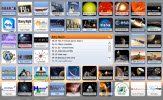Volume 31 Issue 5
May 2025
May 2025
Month at a Glance:
This month the planet viewing opportunities have moved into the morning skies. Thus leaving only Mars as an evening planet visible above the southwestern horizon at sunset. Jupiter is still visible but its position above the western horizon is quickly decreasing. In the morning skies watch for Venus and Saturn to be close to one another throughtout the month, coming the closest around the end of the first week.
This month treat your Mom to a diamond on Mother's Day by taking her outside and helping her to find the 'Diamond of Virgo' a large diamond-shaped (go figure) asterism made up of four stars, each from a different constellation.
Click here for the month at a glance calendar.
What is this? "It's a prediction of when Lees Summit, MO, will have good weather for astronomical observing." Click on the graphic to go to the Clear Sky web site.
This month the planet viewing opportunities have moved into the morning skies. Thus leaving only Mars as an evening planet visible above the southwestern horizon at sunset. Jupiter is still visible but its position above the western horizon is quickly decreasing. In the morning skies watch for Venus and Saturn to be close to one another throughtout the month, coming the closest around the end of the first week.
This month treat your Mom to a diamond on Mother's Day by taking her outside and helping her to find the 'Diamond of Virgo' a large diamond-shaped (go figure) asterism made up of four stars, each from a different constellation.
Click here for the month at a glance calendar.

What is this? "It's a prediction of when Lees Summit, MO, will have good weather for astronomical observing." Click on the graphic to go to the Clear Sky web site.

Mercury puts on a good show, good viewing especially from the Southern Hemisphere in the skies above the eastern horizon before the Sun rises. By the end of the month Mercury will have moved to the opposite side of the Sun and Superior Conjunction.
Venus is very bright and hard to miss over the eastern horizon as it rises before the Sun rises. Venus is somewhat low for Northern Hemisphere observers but its visibility continues to increase daily.
Mars is visible in the evening skies moving steadily across Cancer into Leo. As the distance between the Earth and Mars continues increasing the apparent size and magnitude of the 'Red Planet' decreases.
Dwarf Planet Ceres has an apparent magnitude that stays betwen 8.0 and 9.0 so it is not visible to the naked-eye. It is located within the constellation of Cetus the Whale and is in the planetary company of Saturn, Neptune, Venus, and Dwarf Planet Eris.
Jupiter is visible over the southwestern horizon at sunset but daily it will set closer the local time for sunset, thus being lower above the horizon.
Saturn has been interesting to observe as we are at one of those times when the rings appear edge-on to us. On May 6th Saturn reaches a point where its rings are edge-on to the Sun so for us the rings appear rather narrow.
Uranus reaches solar conjunction around the middle of the month so it will not be visible until it reapears in the morning skies next month.








